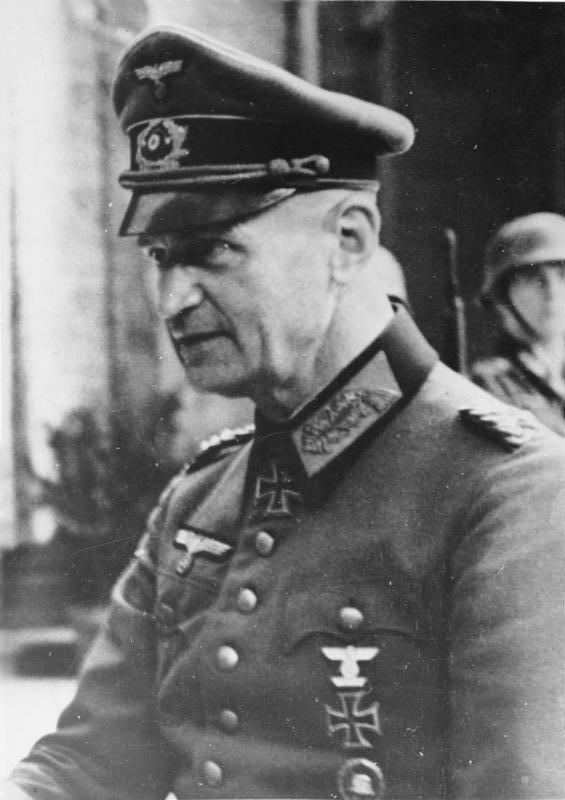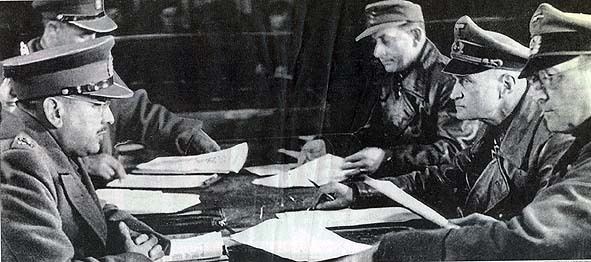Years of service 1901–45 Name Johannes Blaskowitz | Rank Generaloberst Service/branch Wehrmacht | |
 | ||
Birth name Johannes Albrecht Blaskowitz Born 10 July 1883Paterswalde, Province of East Prussia, Kingdom of Prussia, German Empire now Bolshaya Polyana, Kaliningrad Oblast, Russian Federation ( 1883-07-10 ) Battles/wars World War IWorld War II Similar People Charles Foulkes, Gerd von Rundstedt, Tadeusz Kutrzeba, Gunther von Kluge, Walther von Brauchitsch | ||
Johannes Albrecht Blaskowitz (10 July 1883 – 5 February 1948) was a German general during World War II and recipient of the Knight's Cross of the Iron Cross with Oak Leaves and Swords.
Contents
- Early years
- World War I
- Interwar Period
- Poland 1939
- Occupation of France
- Campaign in the West 194445
- Postwar
- Ranks
- Notable decorations
- References

Early years

Johannes Blaskowitz was born on 10 July 1883 in the village of Paterswalde, (East Prussia), Germany (now Bolshaya Polyana in the Kaliningrad Oblast, Russia). He was the son of a Protestant pastor, Hermann Blaskowitz, and his wife Marie Blaskowitz, nee Kuhn. In 1894, Blaskowitz joined cadet school at Koslin (now Koszalin, Poland) and afterwards at Berlin Lichterfelde. In 1901, he started his military career as an officer candidate cadet in an East Prussian regiment in Osterode (Polish: Ostroda).
World War I

During World War I, Blaskowitz served on the Eastern and Western Fronts and was employed in the General Staff. He rose to command an infantry company by 1918, and was awarded the Iron Cross for bravery.
Interwar Period
Blaskowitz's war service secured him a place in the small postwar Reichswehr during the Weimar Republic, through whose ranks he rose to the rank of General. His attitude towards the Nazis' seizure of power in 1933 was reportedly indifferent because he believed that the armed forces should be "politically neutral".
In early 1939 he commanded the German forces that occupied Austria and Czechoslovakia, and was promoted to General of Infantry and given command of the 8th Army just prior to the outbreak of World War II
Poland 1939
During the Invasion of Poland that began World War II, the 8th Army under Blaskowitz's command participated in the Battle of the Bzura. He commanded the army as it besieged Warsaw. After the campaign, he was awarded the Knight's Cross of the Iron Cross (Ritterkreuz des Eisernen Kreuzes), promoted to Colonel-General and appointed as Commander-in-Chief East in Poland on 20 October 1939.
As a traditional soldier, Blaskowitz kept a firm control on the men under his command in their dealings with civilians and was opposed to the Army participation war crimes by the SS and Einsatzgruppen. Between November 1939 and February 1940 he wrote several memoranda to higher military officials, in which he detailed SS atrocities in Poland, their negative effects on Wehrmacht soldiers and the insolent attitude of the SS toward the army. However, his protests failed to produce results, and merely earned him the enmity of Hitler, Hans Frank, Reinhard Heydrich and Heinrich Himmler, while Chief of Staff Alfred Jodl dismissed them as naive and "uncalled for". Commander-in-Chief Walther von Brauchitsch forwarded Blaskowitz's first memorandum to Hitler on 18 November, who launched a tirade against Blaskowitz, denouncing his concerns about due process as "childish" and poured scorn on his "Salvation Army attitude." As a result, Blaskowitz was relieved of his command on 29 May 1940.
Occupation of France
Following the Fall of France in May 1940, Blaskowitz was initially slated to command the 9th Army for occupation duties, but the appointment was blocked by Hitler and instead he was appointed to a relatively minor position as Military Governor of Northern France, a position he held until October 1940, when he was transferred to the command of the 1st Army, on the southwest coast between Brittany and the Spanish border.
In May 1944, following the appointment of Gerd von Rundstedt as Commander-in-Chief in the West, Blaskowitz was appointed head of Army Group G. This comparatively small command, consisting of the 1st Army and the 19th Army, was given the task of defending southern France from the imminent Allied invasion.
The invasion of southern France commenced on 15 August 1944, with Operation Dragoon, when Allied forces landed on the Riviera between Toulon and Cannes. Blaskowitz, though badly outnumbered and lacking air defense, brought up troops, stabilized the front, and led a fighting withdrawal to the north to avoid encirclement. U.S. Army units pursued Blaskowitz's forces up through the Vosges mountains before pausing to regroup and refuel. There, Blaskowitz's troops were reinforced by the 5th Panzer Army under Hasso von Manteuffel. Blaskowitz wanted to entrench his forces, but Hitler ordered him to immediately counterattack the U.S. Third Army. Both Manteuffel and Blaskowitz realized the futility of such an action, but obeyed orders, and their attack caught U.S. forces in disarray and pushed them back to near Luneville on 18–20 September 1944, at which point resistance stiffened and the attack was suspended. As a result, Hitler summarily relieved Blaskowitz, replacing him with Hermann Balck.
Campaign in the West 1944–45
In December 1944, Blaskowitz was recalled to his previous command and ordered to attack in the vicinity of Alsace-Lorraine in support of the ongoing Ardennes offensive. On 1 January 1945 Army Group G engaged the U.S. 7th Army during Operation Nordwind, forcing them to withdraw.
Blaskowitz was subsequently transferred to Holland, where he succeeded Kurt Student as commander of Army Group H. For the following three months he conducted a fighting withdrawal against the British 2nd Army, being awarded the Swords to his Knight's Cross. This command was redesignated in early April 1945 and Blaskowitz became commander-in-chief of the northern (still occupied) part of the Netherlands. From 29 April, Blaskowitz allowed Allied airdrops of food and medicine to the Dutch civilian population in operations Manna and Chowhound.
On 5 May Blaskowitz was summoned to the Hotel de Wereld in Wageningen by General Charles Foulkes, (commander of I Canadian Corps), to discuss the surrender of the German forces in the Netherlands. Prince Bernhard, acting as commander-in-chief of the Dutch Interior Forces, attended the meeting. Blaskowitz agreed with all proposals by Foulkes. However, nowhere in the building – some sources say nowhere in the whole town – could a typewriter be found. Thus, the surrender document could not be typed. The next day, both parties returned and, in the presence of both Foulkes and Prince Bernhard, Blaskowitz signed the surrender document, which in the meantime had been typed.[1]
Postwar
Blaskowitz was charged with war crimes during the Nuremberg Trials in the High Command Trial (Case No. XII). He committed suicide on 5 February 1948: after breaking away from his guards, he threw himself off a balcony into the inner courtyard of the court building.
